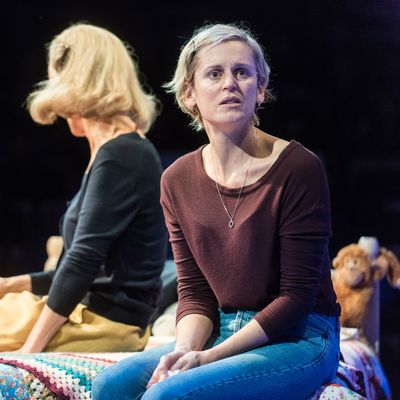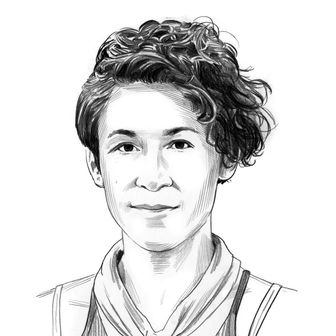
Duncan Macmillan’s merciless, electric People, Places & Things — now playing at St. Ann’s Warehouse in a production from London’s National Theatre — starts with a play and ends with an audition. Yet this isn’t theater about theater. It’s about addiction — the brutal struggle to get and stay sober in world that often feels too awful to move through without some kind of buffer. Its protagonist, the frightened and frightening Emma, is an actress, and as she works her way through rehab, we witness role-playing, rehearsals, performances, naked vulnerability, toxic egotism, and, most terrifyingly of all, the unreliability of something as basic as identity — her name, her story, who she is. Macmillan’s play is a searing exploration of a still-taboo subject, brilliantly elucidated through its parallels with his own chosen art form.
Emma comes roaring into chaotic, devastating life in the person of Denise Gough, who won the Olivier Award for the London production and will be visiting New York again this spring as Harper in the Broadway transfer of the National’s Angels in America revival. The story goes that Gough — an extraordinary actress who, paradoxically, hadn’t yet achieved widespread recognition because of her penchant for disappearing into roles — was on the verge of abandoning acting when Macmillan’s play came along. Now, her performance as Emma has been compared to Mark Rylance’s stage-shaking turn in Jerusalem, and hailed a “tour de force” enough times for her to add the phrase to her business card. It’s safe to say her — or Emma’s — reputation preceded her to Brooklyn. And the rumors are true. She is that good.
I once watched the demolition of an old sports stadium via several tons of controlled explosives. Watching Gough in People, Places & Things has a similar effect: exhilarating and scary. You don’t quite expect just how much your bones are going to shudder with the blast. When we first meet Emma, the character is herself in character, onstage as Nina in The Seagull. After a frantic, garbled crescendo of noise in the darkness (the pulsing, innards-gripping sound design is by Tom Gibbons), the lights snap up on Chekhov’s fourth act. Konstantin is holding forth about his unhappiness, his inability to write, his undying love for Nina, while Nina … is losing it. Gough sways and staggers, her spine seemingly trying to exit her body. She twitches when the lights flicker and jumps at sounds that her scene partner doesn’t hear. Her speech is heavy and slurred, her eyes glassy. Her acting is, at once, undeniably terrible and strangely mesmerizing. When Gough blurts out Nina’s famous “I’m a seagull! No, that’s not right, I’m an actress,” it’s funny and it’s sickening. She has no idea who or where she is.
One whirlwind of a transition later, Emma is checking herself into a rehab clinic (and doing a line of coke on the reception desk counter while she’s at it). The Seagull was the last straw. After blacking out on stage, Emma is finally trying to get clean. She’s on the phone with her mother (who’s stripping Emma’s apartment of anything drug- or alcohol-related), alternating between childlike supplication and bleary abuse. And she’s still high. “Can you tell me what you’ve taken?” asks Foster (the sympathetic Alistair Cope), an addict-in-recovery and now staff member at the clinic. Emma’s list starts with red wine. And weed. And gin. And “a couple of beta-blockers and some ibuprofen too.” Plus some speed — “just to balance me out.” And the coke. And the prescriptions … Valium, benzodiazepine, Ativan. Some cigarettes. Oh, and a multivitamin.
Again, funny — especially with Gough’s bleak, thick-tongued delivery — and sickening. Throughout People, Places & Things, Macmillan and director Jeremy Herrin expertly walk the line between morbid humor and excruciating honesty. And because they’re British, even in the production’s most emotionally raw moments, they never stray into mawkishness. Instead, Herrin keeps things moving — Emma’s life pushes mercilessly and, she fears, meaninglessly forward, so the play sweeps her along without sentiment or respite.
While Emma is still in the grip of the various substances she abuses, the play’s very atmosphere shifts and twists around her in truly creepy ways. It’s the pathetic fallacy … on drugs. During her intake conversation with Foster, a second Foster suddenly springs up out of the reception desk — same beard, same bandanna, speaking in unison with Foster No. 1. As Emma undergoes her first medical exam at the clinic, the walls on either side of her seem to suddenly start crumbling, pieces of shattered stone floating toward the ceiling (Bunny Christie’s sterile white chamber of a set is the perfect canvas for such uncanny moments of projection design, executed by Andrzej Goulding). Most unnerving of all is the extended sequence in which Emma, in the vicious throes of detox, is suddenly visited by a convulsing, screaming array of other Emmas. Bodies that look like hers — with her hair, her clothes, her twitches — emerge from hidden nooks and crannies in the set like cockroaches. In this dance of the demons, it’s hard to keep track of which one is Denise Gough. The effect is terrifying and simultaneously full of pathos: This is the world that that those on the outside of addiction can’t see. This is the suffering that deserves our attention and empathy.
But the brilliance of People, Places & Things is that empathy — vital though it may be — is no cure-all. The play isn’t leading toward a group hug. Catharsis is what Emma and all her fellow addicts in the clinic’s group (which Emma initially resists attending) are seeking, but catharsis is for Greek tragedies. Life doesn’t grant that kind of release. There’s a reason Foster laughs when Emma, coming out of withdrawal, says she feels “like the worst is over.” Her hallucinations are one kind of hell, but far more terrible is what comes after — when she has to face those dull, inescapable nouns of the title. The people, places, and things that trigger her, that make her want to hide, to escape, to use.
The play’s emotional climax comes when Emma — having relapsed, hit rock bottom, returned to the clinic, and finally completed the program there — goes home to stay with her parents. Now, she attempts the performance she has been rehearsing in group, a scene far more difficult than Nina and Konstantin’s, which she hopes will play out as a moment of confession and absolution. To Emma, all the doctors at the clinic look like her mother (they’re all played by the same immensely powerful actress, Barbara Marten). Now, we meet the woman that skeptical Emma has called “my higher power” in the flesh. When she sits her parents on her bed, next to her old stuffed animals, and begins her practiced apology, the results are more shattering than we could have possibly imagined. It’s a stunning gut-punch of a scene by all three actors: Gough reeling in pain and fighting to stay the course, Marten heartrendingly blunt in her rejection of her daughter’s performance, and Kevin McMonagle full of long-repressed anger and suffering as Emma’s father, a man who sees through his child’s toxic self-obsession and yet still loves her.
It’s far from the sympathetic star turn Emma imagined when she rehearsed this scene at the clinic. And for the audience, it cuts even more shocking holes in our picture of who our heroine really is. There’s no catharsis in sight. Just a take-out dinner with her parents, an AA meeting, a bland corporate audition. Another struggle, another risk, another act of vulnerability. Another painful opportunity to walk out into the world without a mask — drugs, drink, a stage role — simply asking for that most frightening of things: not to be forgiven, but to be seen.


